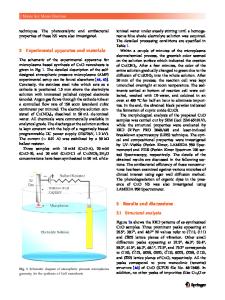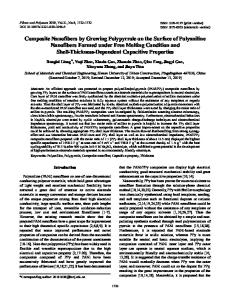Polyaniline nanofibers prepared by a facile electrochemical approach and their supercapacitor performance
- PDF / 1,012,113 Bytes
- 7 Pages / 612 x 792 pts (letter) Page_size
- 41 Downloads / 372 Views
Jixiao Wang,a) Zhi Wang, and Shichang Wang State Key Laboratory of Chemical Engineering, Chemical Engineering Research Center, School of Chemical Engineering and Technology, Tianjin University, Tianjin 300072, People’s Republic of China (Received 9 November 2007; accepted 11 March 2008)
Polyaniline (PANI) nanofibers were prepared electrochemically by a template-free method on different active substrates in aqueous solutions containing aniline and inorganic acid or organic acid. The influences of experimental parameters, such as polymerization potential, techniques of applied potential, electrolyte composition, and polymerization temperature, on the morphologies of the PANI nanofibers were systematically investigated. The PANI nanofibers obtained have promising applications in supercapacitors whose specific capacitance is as high as 1.21 × 103 F/g, which is the highest value possible using sulfuric acid (1.00 M H2SO4) as electrolyte. In addition, the formation mechanism of PANI nanofibers is discussed.
I. INTRODUCTION
Because of its high electrical conductivity, reversible redox, and doping/dedoping properties, and high environmental stability, polyaniline (PANI) has been studied in great detail. In recent years, one-dimensional (1D) PANI nanostructures, including nanofibers, nanowires, nanorods, and nanotubes, have attracted much attention across scientific and engineering disciplines with the expectation that these materials have superior properties to their bulk counterparts in turn-on/turn-off time, strength, and conductivity.1–3 1D PANI nanostructures are often synthesized chemically by adding oxidants or electrochemically by applying potentials to the electrodes. Chemical preparation methods include “hard and soft” templates, 4–7 nanofiber seeding, 8 dilute solution, 9 oligomer-assisted,10 interfacial,11 and rapid mixing12 polymerization. Removal of templates is tedious, and these 1D nanostructures might be destroyed in this process. Seeding, dilute solution, and oligomer-assisted polymerization are all carried out at low concentration, which results in low productivity. Interfacial and rapid mixing approaches developed by Huang should be the preferred methods to prepare pure PANI nanofibers, but the yield is low. Compared with chemical methods, electrochemi-
a)
Address all correspondence to this author. e-mail: [email protected] DOI: 10.1557/JMR.2008.0304 2326
J. Mater. Res., Vol. 23, No. 9, Sep 2008
cal methods have the advantages that polymerization media is simple and can be used repeatedly. The simplicity of the polymerization media makes its discharged liquid easy to treat, and reutilization of polymerization media can, in theory, increase the nanofiber yield. Although aniline polymerization by electrochemical methods is reported elsewhere,13,14 the productivity is usually low (because the deposition area is usually small) and the electrochemical conditions are rigorous, which might restrict practical and extensive applications. Moreover, use of various electrochemical routes to directly deposit PAN
Data Loading...











